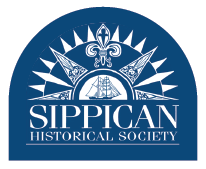
It is nearly common knowledge in this area that President Cleveland and his wife Frances Folsom Cleveland summered in Marion for several years, beginning in 1884 when he first took office. They first rented the house at 192 Front Street built by H.H. Richardson, which at the time belonged to the Rev. Percy Brown; they then rented at 182 Front Street (“the old Walter Hellier home”), and finally at 46 Water Street, which Cleveland enjoyed so much that he attempted to purchase it. The story goes that the then-owners raised the price rather outrageously, so Cleveland decided to buy a home in Bourne instead – the house known as “Grey Gables.”
Also common knowledge is the fact that President Cleveland loved to fish. Cleveland Ledge is named for the president, who went out often with a number of Marion summer friends, including editor Richard Watson Gilder, with whom he maintained a long friendship and an active correspondence. (Incidentally, the SHS has in its collections a copy of the collected letters of Grover Cleveland, 1850-1908; more than four dozen of the letters are to Richard Watson Gilder).
What may not be widely known is that the $20 bill, printed by the U.S. Treasury, once bore President Cleveland’s image. He graced the front of the bill for fourteen years beginning in 1914, being replaced by Andrew Jackson in 1928. Jackson’s image remains on the $20 bill to this day; it is unclear why Cleveland was replaced. According to the Bureau of Engraving and Printing, the “Secretary of the Treasury is responsible for the selection of the designs, including the portraits, which appear on paper currency,” per a July 11, 1862 Act of Congress.
In 2015, after a popular campaign to put a woman on the $20 bill, Harriet Tubman was proposed as a successor to Andrew Jackson. In 2016, then-Secretary Jack Lew suggested that Tubman would replace Andrew Jackson on the $20 bill, and Jackson would be moved to the back of the bill; however, this decision has been placed on hold for the indefinite future by current Secretary of the Treasury Steve Mnuchin.
The $20 bill bearing President Cleveland’s image, in circulation for only fourteen years, is now worth approximately $90, and the Sippican Historical Society is very pleased to have one of these bills in our archives. The reverse of the bill shows four forms of transportation in use in the first quarter of the 20th century – a locomotive, a steam ship, a motor car, and a tugboat (see below). It is really quite a beautiful engraving – why not stop in and see it sometime?
Happy Presidents’ Day!

